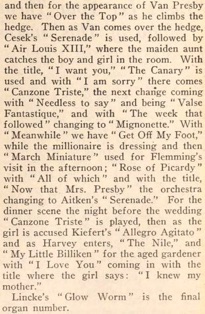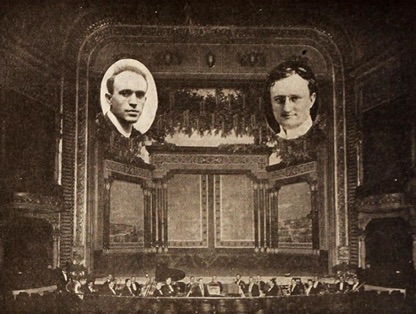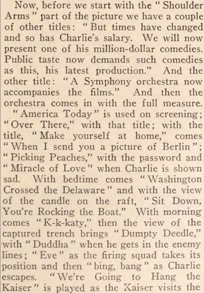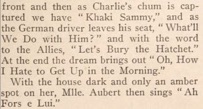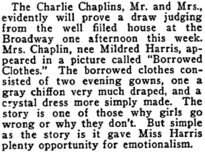Shoulder Arms 1914 1919 next previous
Shoulder Arms Clippings 137/246
Variety, New York, November 22, 1918.
The new stage setting and the orchestra at the Broadway
Theatre, with an insert of Maurice A. Kashin, the
managing director, at the left and James C. Bradford,
musical director, at the right.
(...) Motion Picture News, Jan. 11, 1919
& The Broadway.
CHARLES CHAPLIN in His First and Last, is the way
that Maurice A. Kashin is advertising one of the
two features at the Broadway theatre this week. Now, please
note there are no quotes on the title, for there is no
effort to make this appear a new picture, for it is plainly told
that this was made up by including „The Pest,“ formerly
known as „Kids Auto Race,“ the first motion picture he made,
and „Shoulder Arms,“ his latest one. May Murray
in „The Scarlet Shadow“ is the feature.
Now, „Shoulder Arms“ has played at the Broadway seven
weeks, first as featured, then along with a Mildred
Harris picture with the two featured as „Mr. and Mrs. Charles
Chaplin,“ and now under the present arrangement.
It is a stunt that any exhibitor who has already played
„Shoulder Arms“ can work and arouse new
interest. But we want to advise you to follow the Kashin plan
and tell the people exactly what His First and Last
is; that is not only the honest thing, but it is the way to get
the money. Read the details of how Mr. Kashin put
this combined picture on.“ (...)
Organ music carries „Topics of the Day“ which follows
and then comes the Chaplin stunt. After the title,
„Broadway theatre presents Charles Chaplin in His First and
Last,“ there comes this foreword:
„The successful theatrical manager‘s greatest asset
is his ability to judge public taste. It is interesting
to note how public taste has changed in the matter of motion
picture comedies. With that idea in mind I am offering
for your contemplation the first and latest comedies featuring
Charlie Chaplin. You will be forced to admit, I think,
that public taste has greatly changed. About seven years
ago you were probably one of those who split
their sides laughing at Charlie Chaplin‘s first capers
before a camera. – M. KASHIN.“
Then comes the second title, saying, „Charlie Chaplin
was paid exactly $3.50 for his work in the film
that follows.“ Then comes „The Pest,“ and it gets a world
of laughs. It consists simply of the antics of the
comedian constantly getting in front of a motion picture
camera when the cameraman is trying to film
auto races.
But something which adds a great deal to this is the way
that it has been put on, for before the picture starts
we have a title saying: „This is the music they played in those
days,“ and then we have the piano and drums used
in the same tin-panny effects that we were so familiar with
in the days of the old „movie show.“
Now, before we start with the „Shoulder Arms“ part
of the picture we have a couple of other titles:
„But times have changed and so has Charlie‘s salary.
We will now present one of his million-dollar
comedies. Public taste now demands such comedies
as this, his latest production.“ And the other title.
„A Symphony orchestra now accompanies the films.“ And then
the orchestra comes in with the full measure.
„America Today“ is used on screening: „Over There,“
with that title; with the title, „Make yourself at home,“
comes „When I send you a picture of Berlin“; „Picking Peaches,“
with the password and „Miracle of Love“ when Charlie
is shown sad. With bedtime comes „Washington Crossed the
Delaware“ and with the view of the candle on the raft,
„Sit Down, You‘re Rocking the Boat.“ With morning comes
„K-k-katy,“ then the view of the captured trench brings
„Dumpty Deedle,“ with „Duddha“ when he gets in the enemy
lines: „Eve“ as the firing squad takes its position and
then „bing, bang“ as Charlie escapes. „We‘re Going to Hang
the Kaiser“ is played as the Kaiser visits the front
and then as Charlie‘s chum is captured we have „Khaki Sammy,“
and as the German driver leaves his seat, „What‘ll
We Do with Him?“ and with the word to the Allies, „Let‘s Bury
the Hatchet.“ And the end the dream brings out „Oh.
How I Hate to Get Up in the Morning.“
Then comes the feature, Mae Murray in „The Scarlet
Shadow.“ (...)
Lincke‘s „Glow Worm“ is the final organ number.
(...) Motion Picture News, March 1, 1919.
The Pest is Kid Auto Races at Venice, Cal., but
it isn‘t the first picture in which Chaplin
appears, it is the first, in which he appears as tramp.
– Seven years ago? Tin pan piano? Kid Auto
Races at Venice, Cal. is shown with full orchestra at the
Strand Theatre in New York four years ago.
& BROADWAY (...)
10 A. M. to Midnight (...)
Charlie Chaplin
In „His First and Last“
(...) New York Tribune, Feb. 25, 1919
Broadway Theatre, 1681 B‘way (at 41st St.), New York.
Shoulder Arms Re-run.
„Judging from the well filled house at the Broadway“
Editorial content. „The Charlie Chaplins, Mr. and Mrs.,
evidently will prove a draw judging from the
well filled house at the Broadway one afternoon this week.
Mrs. Chaplin, nee Mildred Harris, appeared
in a picture called Borrowed Clothes. The borrowed
clothes consisted of two evening gowns, one
a gray chiffon very much draped, and a crystal dress more
simply made. The story is one of those why
girls go wrong or why they don‘t. But simple as the story
is it gave Miss Harris plenty opportunity for
emotionalism.“
Broadway Theatre, B‘way at 41st Street, New York.
Shoulder Arms is released
by First National October 27, 1918.
Redaktioneller Inhalt
Shoulder Arms 1914 1919 next previous


